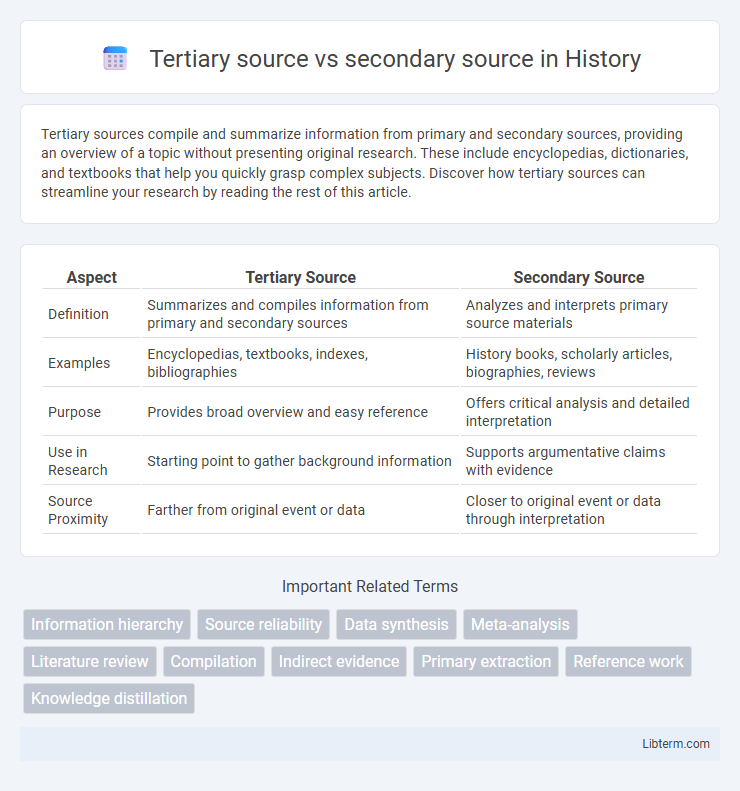Tertiary sources compile and summarize information from primary and secondary sources, providing an overview of a topic without presenting original research. These include encyclopedias, dictionaries, and textbooks that help you quickly grasp complex subjects. Discover how tertiary sources can streamline your research by reading the rest of this article.
Table of Comparison
| Aspect | Tertiary Source | Secondary Source |
|---|---|---|
| Definition | Summarizes and compiles information from primary and secondary sources | Analyzes and interprets primary source materials |
| Examples | Encyclopedias, textbooks, indexes, bibliographies | History books, scholarly articles, biographies, reviews |
| Purpose | Provides broad overview and easy reference | Offers critical analysis and detailed interpretation |
| Use in Research | Starting point to gather background information | Supports argumentative claims with evidence |
| Source Proximity | Farther from original event or data | Closer to original event or data through interpretation |
Understanding Information Sources
Tertiary sources summarize and consolidate information from primary and secondary sources, providing an overview or index such as encyclopedias and databases. Secondary sources analyze or interpret primary data, including scholarly articles and reviews, offering context and commentary. Understanding the distinction helps researchers effectively evaluate the reliability and depth of information for academic or professional purposes.
What Are Tertiary Sources?
Tertiary sources compile and summarize information from primary and secondary sources, providing an overview or digest of a topic. Common examples include encyclopedias, dictionaries, and fact books, which offer concise and accessible information without original analysis. These sources are useful for quick reference and background research, but they lack the detailed evidence found in secondary or primary sources.
What Are Secondary Sources?
Secondary sources analyze, interpret, or summarize information originally presented in primary sources, offering critical perspectives or evaluations. Examples include scholarly articles, biographies, and reviews, which provide context and commentary rather than firsthand evidence. These sources are essential for understanding historical events, scientific research, or literary works through expert analysis.
Key Differences Between Tertiary and Secondary Sources
Tertiary sources compile and summarize information from primary and secondary sources, providing overviews such as encyclopedias and textbooks, while secondary sources analyze, interpret, or critique primary data, including journal articles and reviews. Tertiary sources prioritize general summaries and broad accessibility, whereas secondary sources offer detailed evaluations and contextual understanding, often with citations of primary material. The key difference lies in their purpose: tertiary sources simplify and condense knowledge, whereas secondary sources engage in in-depth scholarly analysis.
Examples of Tertiary Sources
Tertiary sources compile and summarize information from primary and secondary sources, often providing overviews or quick reference material. Common examples of tertiary sources include encyclopedias, dictionaries, handbooks, indexes, and factbooks. These sources are useful for gaining a broad understanding or quick facts but generally lack the detailed analysis found in secondary sources.
Examples of Secondary Sources
Secondary sources interpret, analyze, or summarize primary sources, providing context and commentary. Examples of secondary sources include scholarly journal articles, biographies, literature reviews, and critical essays. These sources are essential for understanding and evaluating primary data within academic research.
When to Use Tertiary Sources
Tertiary sources are best used for obtaining summarized, easily accessible overviews of broad topics, such as encyclopedias, dictionaries, and factbooks. They provide foundational information quickly, making them ideal for initial research stages or when needing quick reference material without in-depth analysis. Unlike secondary sources that interpret primary data, tertiary sources compile and distill information from multiple secondary and primary sources to present concise, general knowledge.
When to Use Secondary Sources
Secondary sources are ideal for analyzing, interpreting, or summarizing primary data and original research, especially when seeking scholarly opinions or historical context. They provide critical evaluations and syntheses, making them valuable for literature reviews, academic writing, and understanding established theories. Use secondary sources when primary sources are inaccessible or when a comprehensive overview of existing knowledge is required.
Evaluating Credibility in Tertiary vs Secondary Sources
Evaluating credibility in tertiary sources involves assessing summarized information compiled from multiple secondary sources, often lacking in-depth analysis or original interpretation. Secondary sources provide critical evaluation and interpretation of primary data, offering a higher level of credibility due to their analytical depth and referenced evidence. Ensuring the reliability of tertiary sources requires cross-checking with primary and secondary materials, while secondary sources demand scrutiny of the author's expertise and the quality of citations.
Summary: Choosing the Right Source for Research
Tertiary sources, such as encyclopedias and textbooks, provide summarized overviews compiled from primary and secondary sources, making them ideal for initial research and broad understanding. Secondary sources analyze, interpret, or critique primary data and original research, offering detailed discussions useful for in-depth analysis and contextualization. Selecting the right source depends on research goals; tertiary sources aid in foundational knowledge, while secondary sources support critical examination and scholarly argumentation.
Tertiary source Infographic

 libterm.com
libterm.com